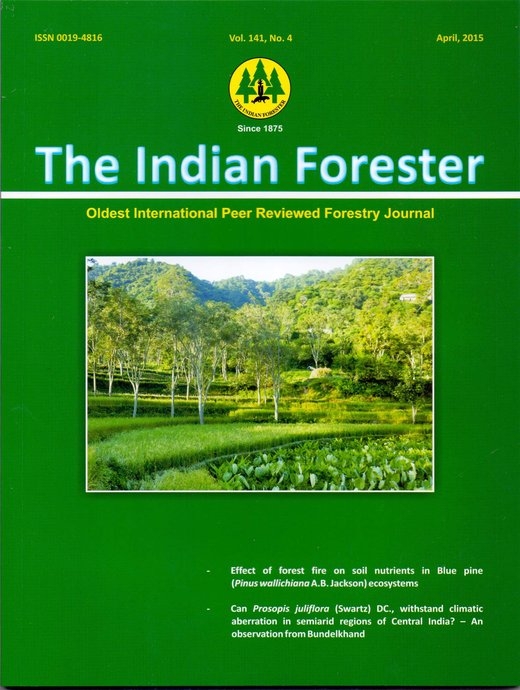Variability and Cluster Analysis of Morpho-Physio Traits of Terminalia tomentosa Germplasm for Identification of Donor Source
DOI:
https://doi.org/10.36808/if/2015/v141i4/68925Keywords:
Terminalia tomentosa, Variability, Cluster Analysis.Abstract
Terminalia tomentosa (Combretaceae) has been well recognized in tropical tasar silk industry as the most important primary food plant. Fifty accessions of T. tomentosa of diverse origin were selected for studying the genetic diversity for 36 morpho-physio-anatomical parameters. Analysis of variance indicated a significant difference among accessions for most of the quantitative characters studied. The maximum coefficient of variation was recorded for phenol (53.21%) followed by proline (52.10%), moisture (50.16%) and protein (43.7%), contents in the leaf. All the accessions were grouped into 7 clusters with maximum accessions (21) in cluster I followed by cluster II and cluster IV having 11 accessions each. Cluster III had 4 accessions and remaining clusters were represented by one accession each. The presence of variability in the 50 germplasm accessions was also reflected in the cluster means for traits studied. Maximum contribution towards genetic diversity (47.92%) was recorded for proline followed by protein (26.37%) contents, thereafter, reducing (10.53%) and non reducing sugar (11.27%) contributed for genetic diversity. The results indicated that pattern of distribution of genotypes into various clusters was at random indicating that geographical distribution and genetic diversity were not related.References
Arunachalam V. and Bandyopadhyay A. (1984). Limits to genetic divergence for occurrence of heterosis: Experimental evidences from crop plants. Indian J. Genet. and Pl. Breed, 44:548-554.
Dwivedi A.K. and Mitra S.K. (1996). Divergence analysis of litchi (Litchi chinensis Sonn) cultivar grown in West Bengal. Indian J.Genet, 56:486-489
Mahalanobis P.C. (1936). On the genetic distance in statistics. Proc. Nat. Ins. Sci. India, 2:49-55.
Mahadevan A. and Sridhar R. (1974). Methods in physiological plant pathology. Sivakami Publication, Chennai.
Mahto C.S. and Dua R.P. (2009). Genetic divergence for yield contributing traits in winged bean [Psophocarpus tetragonolobus L. (DC)]. Indian J. Plant Genet. Resour, 22(3): 239-242
Rajan M.V., Chaturvedi H.K. and Sarkar A. (1997). Multivariate analysis as an aid to genotype selection for breeding in Mulberry. Indian J. Seric., 36(2):111-115
Rao C.R. (1952). Advanced statistical methods in Biometric Research. John Willy & Sons, New York.
Sikdar A.K., Dwivedi N.K., Dandin S.B., Kumar R. and Giridhar K. (1986). Stomatal chloroplast count technique as a tool to ascertain different ploidy levels in Mulberry. Indian J.Seric., 25(2):88-90
Srivastava K.K., Sharma M.K. and Sundauri A.S. (2007). Estimation of genetic divergence in Apricot (Prunus armeniaca L.)J. Plant Genet. Resour., 20(3):234236.
Suryanarayana N., Kumar R. and Gargi (2006). Monograph on Indian Tropical Tasar Silkworm Food Plants ( Terminalia spp). Central Tasar research and training Institute, Nagri, Ranchi.
Tikadar A., Rao A. Ananda and Thangavelu K. (2003). Genetic divergence in exotic mulberry (Morus sp) germplasm. Sericologia., 43(4):495-501.
Downloads
Downloads
Published
How to Cite
Issue
Section
License
Unless otherwise stated, copyright or similar rights in all materials presented on the site, including graphical images, are owned by Indian Forester.





